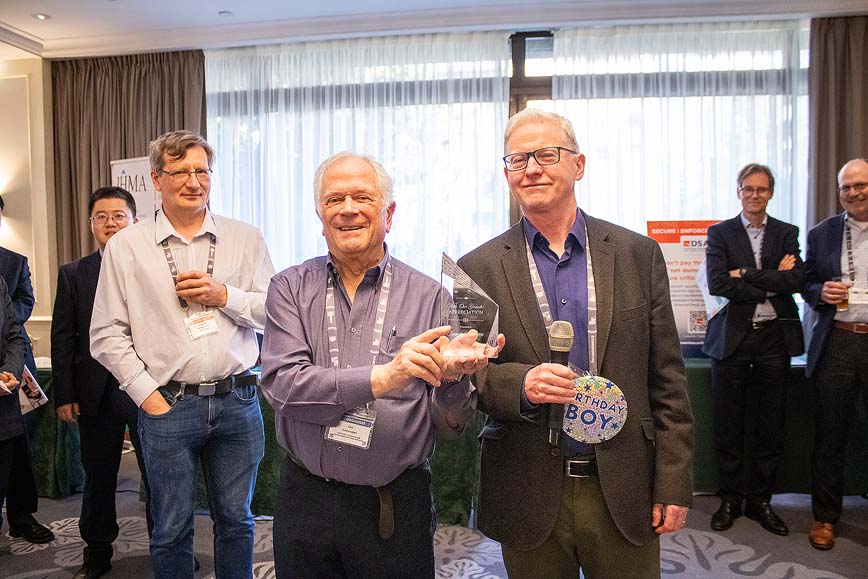



Nestled among seven hills overlooking the Tagus River, Portugal’s vibrant capital city, Lisbon, hosted the Optical & Digital Document Security™ (ODDS) 2024 conference from 8-10 April. In addition to providing a welcoming space for the ID, currency, and secure document technical community to meet and share ideas, the conference once again proved to be the venue of choice for announcing several new security technologies.
As with previous editions of ODDS, the seminars that preceded the two-day conference invited experts to lead in-depth analyses of topical interest in the document security industry.
In the morning session, Franziska Granc and Arno Fiedler from Nimbus Technologies reviewed the EU’s work in setting out rules and structures for a European Digital Identity Wallet. The afternoon seminar, hosted by Prof Dr Volker Lohweg from inIT-Institute Industrial IT, focused on the potential impacts of AI and quantum computing (QC).
While AI, QC, and digital security continued to receive considerable coverage on the first conference day, the second day was largely dedicated to various aspects of optical security.
The editor of Holography News®’ sister publication ID & Secure Document News™, Francis Tuffy, used historical and current news sources to review the development of optically variable devices (OVDs) and consider their future as a means of protecting documents. His paper focused on the diminishing market for physical visas and the growing opportunities from smartphone authentication.
Sajan Ambadiyil from the Centre for Development of Imaging Technology in India conveyed the story of implementing hologram-embedded security tax labels over the previous 20 years and their current transition to taggant-based holographic track and trace labels.
Jérémy Malinge of Crime Science Technology in France, in his paper ‘An OVD Secured by Design’, gave details of a security feature viewable with the naked eye, classical UV light, and the LED light various colourshift innovations launched at ODDS. He then explored his work on foil- based features possessing a two-colour colourshift effect.
With a title like ‘Brilliantly Innovative: a New Security Feature Using Micro-Optical Freeform Elements’, you had better have something impressive to present. And Dr Martin Egginger from Hueck Folien didn’t disappoint. His paper described a new security feature based on freeform micromirrors that enable high visibility of a simple smartphone to gather all the verification modes traditionally used in the field of document security.
With so many types of optical features currently available for document protection, Yit-Sun Leung Ki’s (Security Identity Alliance) paper ‘Modern Optical Features for ID Documents – a Review’ was a timely reminder that there are only a very small number of light-matter phenomena and that from these you can make a succinct but complete review of Level 1 features for ID documentation.
‘Colour-Tuneable Photonic Crystals’ was the subject of Keeyeon Kim’s (NanoBrick, South Korea) presentation, which demonstrated the application of advanced nano-security technologies capable of dynamically altering reflective colours by adjusting the photonic crystal structure in response to an external magnetic or electric field.
Steve Sun from Wuhan Huagong Image Technology in China took a 180-degree view of OVD design in his paper ‘Special Information Encryption for Optical Lithography Technology’. Steve and his team have established a model based on the intended optical effect from which an optical microstructure is simulated and engraved onto photosensitive material.
To round off the optical security part of the conference, Daniel Parrat and Erik Egemalm of Rolling Optics in Sweden explored micro-optics in the fourth dimension, whilst Dr Dong Yang of ZSST (China Banknote Printing and Minting) presented security features based on light-field shaping using freeform microstructures, and Leehwan Hwang of Kwangwoon University in South Korea explored a computer-generated holography solution to print document protection.
ODDS has gained a reputation as THE technical conference for physical, digital and virtual document security and is proud of its status as the birthplace of nascent techniques that reach commercial maturity.
As if to endorse this, Sebastian Mader from OVD Kinegram started his paper ‘Utilising Two-Colour Colourshifts for Highest Security’ by cataloguing the in any lighting and from any angle. When combined with thin film coatings, these micromirrors provide colourful moving effects.
To shake things up a bit, Michael Natan (Diametryx, US) presented a series of novel, ink-based security features comprising micron-scale particles that change colour in response to shaking, tilting, or magnetic fields. The features can create all known colours and enable rapid, simple, unambiguous readouts by the public.
Toppan colleagues Keitaro Sugihara and Yoshiyuki Mizuguchi presented a new optical design that generates achromatic effects at specific angles through a combination of periodic and non- periodic structures.
In his closing remarks, Ian Lancaster went to great lengths to thank the sponsors, tabletop exhibitors, conference organisers, and participants. He also acknowledged the work of the conference committee members in ensuring the high quality of the papers, and the authors for making them so.
This was the last ODDS conference that Ian Lancaster will lead. He has been involved with this conference series from the first Van Renesse event in 1996, leading the evolution of the conference through several iterations to its current format.
Ian, who has been granted the title of Chairman Emeritus, closed the conference by introducing Francis Tuffy as the new Programme Director and wishing him all the best for the next ODDS, to be held in Warsaw, Poland, in autumn 2025.
 Ian Lancaster (left) and Francis Tuffy.
Ian Lancaster (left) and Francis Tuffy.